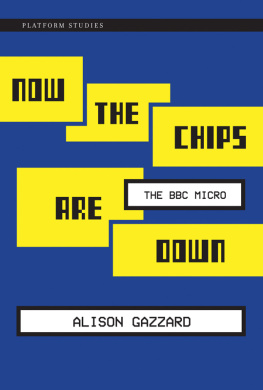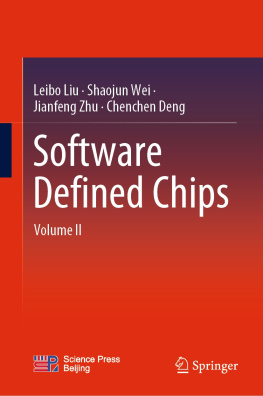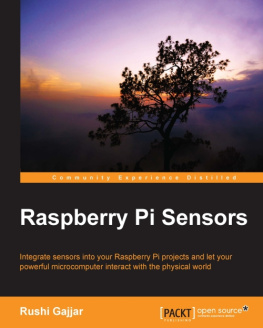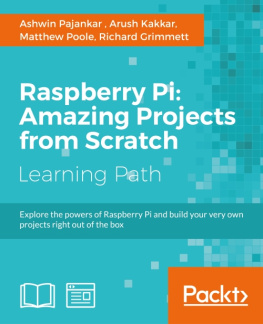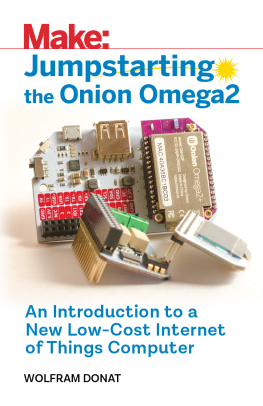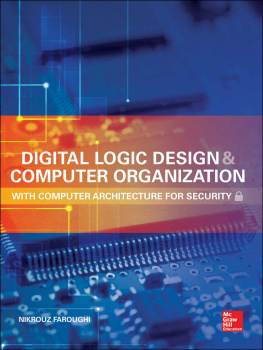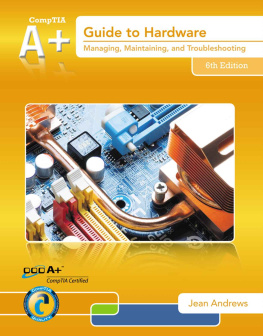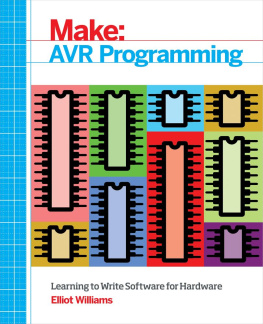Alison Gazzard - Now the Chips Are Down
Here you can read online Alison Gazzard - Now the Chips Are Down full text of the book (entire story) in english for free. Download pdf and epub, get meaning, cover and reviews about this ebook. year: 2016, publisher: The MIT Press, genre: Romance novel. Description of the work, (preface) as well as reviews are available. Best literature library LitArk.com created for fans of good reading and offers a wide selection of genres:
Romance novel
Science fiction
Adventure
Detective
Science
History
Home and family
Prose
Art
Politics
Computer
Non-fiction
Religion
Business
Children
Humor
Choose a favorite category and find really read worthwhile books. Enjoy immersion in the world of imagination, feel the emotions of the characters or learn something new for yourself, make an fascinating discovery.
- Book:Now the Chips Are Down
- Author:
- Publisher:The MIT Press
- Genre:
- Year:2016
- Rating:4 / 5
- Favourites:Add to favourites
- Your mark:
- 80
- 1
- 2
- 3
- 4
- 5
Now the Chips Are Down: summary, description and annotation
We offer to read an annotation, description, summary or preface (depends on what the author of the book "Now the Chips Are Down" wrote himself). If you haven't found the necessary information about the book — write in the comments, we will try to find it.
The story of a pioneering microcomputer: its beginnings as part of a national Computer Literary Project, its innovative hardware, and its creative uses.
Now the Chips Are Down — read online for free the complete book (whole text) full work
Below is the text of the book, divided by pages. System saving the place of the last page read, allows you to conveniently read the book "Now the Chips Are Down" online for free, without having to search again every time where you left off. Put a bookmark, and you can go to the page where you finished reading at any time.
Font size:
Interval:
Bookmark:
Platform Studies
Nick Montfort and Ian Bogost, editors
Nick Montfort and Ian Bogost, Racing the Beam: The Atari Video Computer System (2009)
Steven E. Jones and George K. Thiruvathukal, Codename Revolution: The Nintendo Wii Platform (2012)
Jimmy Maher, The Future Was Here: The Commodore Amiga (2012)
Anastasia Salter and John Murray, Flash: Building the Interactive Web (2014)
Nathan Altice, I AM ERROR: The Nintendo Family Computer / Entertainment System System Platform (2015)
Zabet Patterson, Peripheral Vision: Bell Labs, the S-C 4020, and the Origins of Computer Art (2015)
Alison Gazzard, Now the Chips Are Down: The BBC Micro (2016)
Alison Gazzard
The MIT Press
Cambridge, Massachusetts
London, England
2016 Massachusetts Institute of Technology
All rights reserved. No part of this book may be reproduced in any form by any electronic or mechanical means (including photocopying, recording, or information storage and retrieval) without permission in writing from the publisher.
Set in Filosofia and Helvetica Neue by Toppan Best-set Premedia Limited. Printed and bound in the United States of America.
Library of Congress Cataloging-in-Publication Data
Names: Gazzard, Alison, 1982- author.
Title: Now the chips are down : the BBC Micro / Alison Gazzard.
Description: Cambridge, MA : MIT Press, [2016] | Series: Platform studies |
Includes bibliographical references and index.
Identifiers: LCCN 2015038328 | ISBN 9780262034036 (hardcover : alk. paper)
Subjects: LCSH: BBC MicrocomputerHistory. | Computer literacyGreat
BritainHistory.
Classification: LCC QA76.8.B35 G39 2016 | DDC 004.0941dc23 LC record available at http://lccn.loc.gov/2015038328
ISBN: 978-0-262-03403-6
eISBN: 978-0-262-33431-0 (e-book retail)
eISBN: 978-0-262-33429-7 (MIT e-book)
eISBN: 978-0-262-33430-3 (retail e-book)
10987654321
How can someone create a breakthrough game for a mobile phone or a compelling work of art for an immersive 3D environment without understanding that the mobile phone and the 3D environment are different sorts of computing platforms? The best artists, writers, programmers, and designers are well aware of how certain platforms facilitate certain types of computational expression and innovation. Likewise, computer science and engineering have long considered how underlying computing systems can be analyzed and improved. As important as scientific and engineering approaches are, and as significant as work by creative artists has been, there is also much to be learned from the sustained, intensive, humanistic study of digital media. We believe it is time for humanists to seriously consider the lowest level of computing systems and their relationship to culture and creativity.
The Platform Studies series has been established to promote the investigation of underlying computing systems and of how they enable, constrain, shape, and support the creative work that is done on them. The series investigates the foundations of digital mediathe computing systems, both hardware and software, that developers and users depend upon for artistic, literary, and gaming development. Books in the series will certainly vary in their approaches, but they will all share certain features:
- a focus on a single platform or a closely related family of platforms
- technical rigor and in-depth investigation of how computing technologies work
- an awareness of and a discussion of how computing platforms exist in a context of culture and society, being developed on the basis of cultural concepts and then contributing to culture in a variety of waysfor instance, by affecting how people perceive computing.
The BBC Micro was my first computer. It is a machine I will always remember taking pride of place in our living room as I sat with my dad playing the games he would program. He would later show me how to program my own simple games and animations, as I typed in line after line of code from listings found in books, or we would spend afternoons working our way through countless plays of Grannys Garden and Repton. That original machine now takes pride of place in my own living room, and the archive of those games, books, and manuals remain in my loft. So first and foremost I would like to thank my parents for buying the family Micro, and for many of the memories that found their way into this book.
Those memories were sparked once again in 2012 during my first visit to The National Museum of Computing (TNMOC) in Bletchley. It was there that I met Owen Grover, who replaced the burned-out capacitor in my Micro, and Chris Monk, who runs the educational program at the museum and encourages visiting school groups to spend an hour programming the Micros using BASIC. Chris provided many valuable insights into the BBC Micro, and went out of his way to find some of the many manuals that I worked my way through while researching this book. I am thankful to the museum for providing access to its archive as I read through racks of magazines, and to the visitors who provided their own recollections of the machine on the Sundays that I would help out in the BBC Micro classroom. I will never forget the Sunday, not long before Christmas, when Chris, Dave Sussman, Steve Clark, and I sat programming a Christmas-tree graphic in BASIC to show to visitors in the classroom, and how it took four programmers a good half hour to find where a comma had been omitted in the code.
TNMOC also led me to David Allen, who not only gave an insightful talk into his time working on The Computer Literacy Project but also allowed me to follow up with further questions, which I am truly thankful for. The insights provided by those who helped to develop the platform and those who created content for it were extremely helpful to me while I was writing this book, and for these insights I would like to thank Sophie Wilson, David Braben, and Tim Tyler. Sophies detailed comments on the draft of my manuscript provided further commentary into the development process, for which I am very grateful. I would also like to thank Jon Silvera at FUZE for not only providing his own history of the Beeb but also supplying me with my own Special Edition FUZE casing to go alongside my Micro in the living room.
At the UCL Institute of Education I would like to thank those who attended my lunchtime seminar at the London Knowledge Lab during the early stages of writing this book. Your questions and own memories of using the machine in the classroom all helped to shape some of the research in this book. I would like to thank my colleagues Andrew Burn, John Potter, and Diane Carr for their support while I was writing the book, and John and Andrew for their comments on some of the chapters. I would also like to thank Neil Selwyn, Jussi Parikka, and Tom Apperley for recommendations, advice, and feedback during the writing process.
Some of the material in part II of this book was presented at the 2013 History of Games conference and at the 2014 Game History Annual Symposium, both held in Montreal. I would like to thank not only the organizers of these events but also the attendees and panel members for their insightful comments about computing in various parts of the world in the 1980s. Some of the research presented in chapter 4 about the game Elite was published as The Player and the Platform: Exploring the (Hi)stories of Elite in Game Studies
Font size:
Interval:
Bookmark:
Similar books «Now the Chips Are Down»
Look at similar books to Now the Chips Are Down. We have selected literature similar in name and meaning in the hope of providing readers with more options to find new, interesting, not yet read works.
Discussion, reviews of the book Now the Chips Are Down and just readers' own opinions. Leave your comments, write what you think about the work, its meaning or the main characters. Specify what exactly you liked and what you didn't like, and why you think so.

